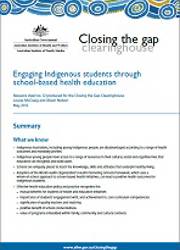Summary
What we know
- Indigenous Australians, including young Indigenous people, are disadvantaged according to a range of health outcomes and morbidity profiles.
- Indigenous young people have access to a range of resources in their cultural, social and cognitive lives that educators can recognise and build upon.
- Schools are uniquely placed to teach the knowledge, skills and attitudes that underpin healthy living.
- Adoption of the World Health Organization’s Health Promoting Schools framework, which uses a whole-of-school approach to school-based health initiatives, can lead to positive health outcomes for Indigenous students.
- Effective health education policy and practice recognises the:
- mutual benefits for students of health and education initiatives
- importance of students’ engagement with, and achievement in, core curriculum competencies
- significance of quality teachers and teaching
- positive benefit of school connectedness
- value of programs embedded within family, community and cultural contexts.
What works
Quality teaching and teachers lie at the heart of initiatives that have successfully enhanced Indigenous students’ health and education performance. Positive health outcomes can be achieved when health education programs are:
- delivered and assessed within the context of the core school curriculum
- provided by trained and well-resourced classroom teachers
- implemented across a substantial time frame and through at least two Health Promoting Schools dimensions
- informed by local health issues, values and beliefs of individual students and their community
- delivered within the context of safe and supportive classroom and school environments
- underpinned by positive partnerships with parents, community members and health professionals
- designed and evaluated according to sound health and educational theory and practice.
What doesn’t work
Past and current initiatives seeking to reduce the educational and health disparities of Indigenous youth have provided some clear indications of what does not work. These sub-optimal programs are typically characterised by:
- ‘quick fix’ strategies that adopt a ‘one-size-fits-all’ approach
- are ad hoc and lack processes for accountability and sustainability
- rely on external speakers or isolated individuals to deliver programs
- practices that reinforce deficit models of Indigenous students
- have limited or non-existent quality partnerships with Indigenous families and communities.
What we don’t know
There are significant gaps in our knowledge about what works, for whom and in what circumstances. Currently, we have gaps in our understanding about:
- whether a number of specific health education practices contribute to positive health-related outcomes for Indigenous students
- barriers and facilitators that influence the successful detailed implementation of broader policy
- the development of health risk or resilience among Indigenous young people
- the overall impact of school-based health education (i.e. conclusive evidence is limited)
- what indicators are most effective in assessing the impact of school-based health education
- uniquely Indigenous approaches to the development of health literacy.
Introduction
What we know
- Motivation for sustained action: health disparities of Indigenous children and students
- Health promoting schools
What works
- Teaching and learning
- School policy and ethos
- School-community relationships
What doesn’t work
What we don’t know
Conclusion
End matter: References; Acknowledgments; Abbreviations; Terminology; Funding; Suggested citation; Copyright



